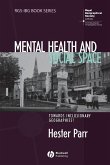In the nineteenth century, 'the mad' were segregated in special asylum spaces; in the later twentieth century, these spaces were dismantled and patients discharged into the community. Now, in the twenty-first century, 'community care' is still in vogue, but what has happened to the people with mental health problems? Stories of neglect, ghettoization, homicide, and reinstitutionalization regularly litter the pages of newspapers and academic journals. Is this the whole story? Are those with severe and enduring mental health problems still living on the edges of society? This book illuminates the complicated reality of people living with mental health problems. It focuses on their voices, relationships, and achievements through case studies tracing innovative examples of community activity that are creating versions of social tolerance, social recovery, and peer and self-help for this consistently marginalized group. People with mental health problems are active in rescripting their own social recoveries, using different community spaces to create pathways to psychological and social stability.
Hinweis: Dieser Artikel kann nur an eine deutsche Lieferadresse ausgeliefert werden.
Hinweis: Dieser Artikel kann nur an eine deutsche Lieferadresse ausgeliefert werden.
"Hester Parr's book delivers a welcome and unusually close-upengagement with the practiced geographies of mental health." (Area,December 2010)
"This inspiring book offers a highly original account of thesocial spaces created and inhabited by people with mental healthproblems. Hester Parr paints a vivid picture, which foregroundshopeful possibilities for empowerment and integration. It will beinvaluable to anyone seeking to understand mental (ill) health inthe twenty-first century."
Liz Bondi, University of Edinburgh
"Parr's efforts to advance a 'cautiousoptimism"'about the lived social geographies of people withmental health problems, based on rich empirical material andthoughtful conceptual articulation, make this an essential read foranyone interested in the changing social geographies of mentalhealth. The book also has considerable relevance for broaderdebates about social inclusion and active citizenship incontemporary Western societies."
Robert Wilton, McMaster University
"Parr has ... redefine[ed] 'the mentalpatient', a crucial undertaking if social citizenship forpeople with mental illness is to become an enduring reality."Metapsychology
"This book could appeal to psychologists who enjoyrelevant work in other disciplines, who find ideas of people likeFreud and Foucault interesting, and who value small casestudies." PsycCritiques
"This inspiring book offers a highly original account of thesocial spaces created and inhabited by people with mental healthproblems. Hester Parr paints a vivid picture, which foregroundshopeful possibilities for empowerment and integration. It will beinvaluable to anyone seeking to understand mental (ill) health inthe twenty-first century."
Liz Bondi, University of Edinburgh
"Parr's efforts to advance a 'cautiousoptimism"'about the lived social geographies of people withmental health problems, based on rich empirical material andthoughtful conceptual articulation, make this an essential read foranyone interested in the changing social geographies of mentalhealth. The book also has considerable relevance for broaderdebates about social inclusion and active citizenship incontemporary Western societies."
Robert Wilton, McMaster University
"Parr has ... redefine[ed] 'the mentalpatient', a crucial undertaking if social citizenship forpeople with mental illness is to become an enduring reality."Metapsychology
"This book could appeal to psychologists who enjoyrelevant work in other disciplines, who find ideas of people likeFreud and Foucault interesting, and who value small casestudies." PsycCritiques








